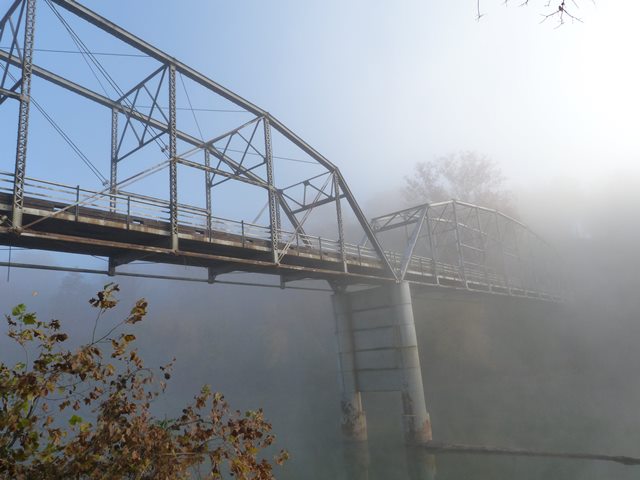We Recommend:
Bach Steel - Experts at historic truss bridge restoration.
Bend Road Bridge
Withington Ford Bridge

Primary Photographer(s): Nathan Holth
Bridge Documented: November 2, 2013
Rural: Franklin County, Missouri: United States
Metal 10 Panel Pin-Connected Pennsylvania Through Truss, Fixed and Approach Spans: Wood Stringer (Multi-Beam), Fixed
1916 By Builder/Contractor: Miller and Borcherding of St. Louis, Missouri
1991
200.0 Feet (61 Meters)
422.0 Feet (128.6 Meters)
14 Feet (4.27 Meters)
2 Main Span(s) and 1 Approach Span(s)
15356

View Information About HSR Ratings
Bridge Documentation
This bridge no longer exists!
Bridge Status: Demolished and replaced.View Archived National Bridge Inventory Report - Has Additional Details and Evaluation
This bridge is a rare example of a pin-connected Pennsylvania through truss. It was built by a local bridge builder, Miller and Borcherding. The portal bracing knees were removed likely to increase vertical clearance. Otherwise it retains good historic integrity.
The bridge is currently at risk for demolition and replacement. It recently has been closed to traffic by its owner, Franklin County, who disagrees with an engineer's assessment that the bridge is safe for loads under 12 tons even without rehabilitation. The truth is that if maintained pin-connected truss bridges such as this one are one of the most reliable bridge types around. Consider that surviving examples of this bridge type today essentially prove that these bridges can provide safe and reliable service for a century and well beyond. If this bridge were rehabilitated by a firm with experience restoring bridges of this type, the bridge could moreover be restored to like-new condition and be made ready for another century of use. Even without rehabilitation, the bridge is not in horrible condition. This is a bridge that is feasible to preserve and it should be preserved. While the bridge could be relocated and reused for non-motorized traffic in a park or on a trail, or could be left in place and preserved for pedestrian use (an idea that some have suggested) there is no reason why this bridge could not be rehabilitated for continued light vehicular use. Any of these preservation solutions would be preferable to the idea of demolishing and replacing this historic bridge.
The Historic Bridge Inventory mentions that Illinois Steel Company steel was used. In reality steel from multiple mills including Illinois, Lackawanna, and Jones and Laughlin.
Information and Findings From Missouri's Historic Bridge InventoryBridge Features upper chord and inclined end post: 2 channels with cover plate and lacing; lower chord: 2 punched rectangular eyebars; vertical: 2 channels with lacing; diagonal: 2 punched rectangular eyebars; lateral bracing: round rod with threaded ends; strut: 2 angles, braced; floor beam: I-beam, field bolted to vertical; guardrail: 2 angles; Discussion of Bridge With its wide channel and high bordering cliffs, the Meramec River proved to be a formidable obstacle to overland travelers in central Franklin County. Local citizens began subscribing for a bridge over the river on the Catawissa-Pacific Road as early as 1892. The Withington Ford crossing, as it was known locally, became the object of repeated petitions to - and rejections by - the county court over the next 23 years. The judges finally directed county engineer J.M. Moore to design a bridge for the crossing in December 1915. Moore delineated a pair of 200-foot Pennsylvania through trusses, with typical pin-connected detailing, supported by concrete abutments and center pier. After receiving competitive proposals from nine bridge companies later in the month for the Withington Ford and Hartmann's Ford (FRAN23) bridges, the county selected the East St. Louis Bridge Company to erect the two trusses. For an unknown reason, the bridge company asked to be released from its bid, however, and in February 1916 the St. Louis firm of Miller and Borcherding agreed to construct both bridges for the same price. Construction proceeded slowly throughout the next two years. Using steel components milled by the Illinois Steel Company of Chicago, Miller and Borcherding completed the Withington Ford Bridge in December 1917 for the contract cost of $13,832.00. It has carried traffic since, with only minor maintenance-related repairs. Serving as a major crossing of the Meramec River for more than seventy years, the Withington Ford Bridge is historically significant for its longstanding role in the development of regional transportation. The structure's channel spans are technologically significant as well preserved examples of a Pratt truss subtype-the Pennsylvania through truss. With their polygonal top chord and subdivided panels, the trusses exemplify this relatively uncommon truss type which was used primarily at long-span crossings after the tum of the century. As a rare multiple-span example of this configuration, the Withington Ford Bridge is one of the state's more noteworthy roadway trusses dating from the 1910s. Bridge Considered Historic By Survey: Yes |
![]()
Photo Galleries and Videos: Bend Road Bridge
Bridge Photo-Documentation
Original / Full Size PhotosA collection of overview and detail photos. This gallery offers photos in the highest available resolution and file size in a touch-friendly popup viewer.
Alternatively, Browse Without Using Viewer
![]()
Bridge Photo-Documentation
Mobile Optimized PhotosA collection of overview and detail photos. This gallery features data-friendly, fast-loading photos in a touch-friendly popup viewer.
Alternatively, Browse Without Using Viewer
![]()
Maps and Links: Bend Road Bridge
This historic bridge has been demolished. This map is shown for reference purposes only.
Coordinates (Latitude, Longitude):
Search For Additional Bridge Listings:
Bridgehunter.com: View listed bridges within 0.5 miles (0.8 kilometers) of this bridge.
Bridgehunter.com: View listed bridges within 10 miles (16 kilometers) of this bridge.
Additional Maps:
Google Streetview (If Available)
GeoHack (Additional Links and Coordinates)
Apple Maps (Via DuckDuckGo Search)
Apple Maps (Apple devices only)
Android: Open Location In Your Map or GPS App
Flickr Gallery (Find Nearby Photos)
Wikimedia Commons (Find Nearby Photos)
Directions Via Sygic For Android
Directions Via Sygic For iOS and Android Dolphin Browser
USGS National Map (United States Only)
Historical USGS Topo Maps (United States Only)
Historic Aerials (United States Only)
CalTopo Maps (United States Only)

